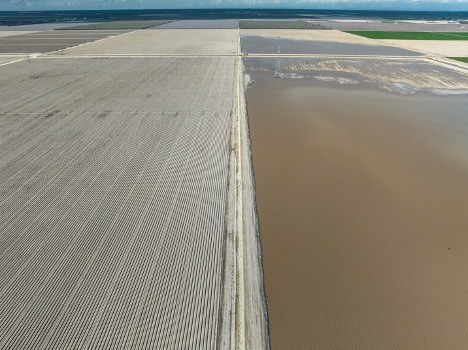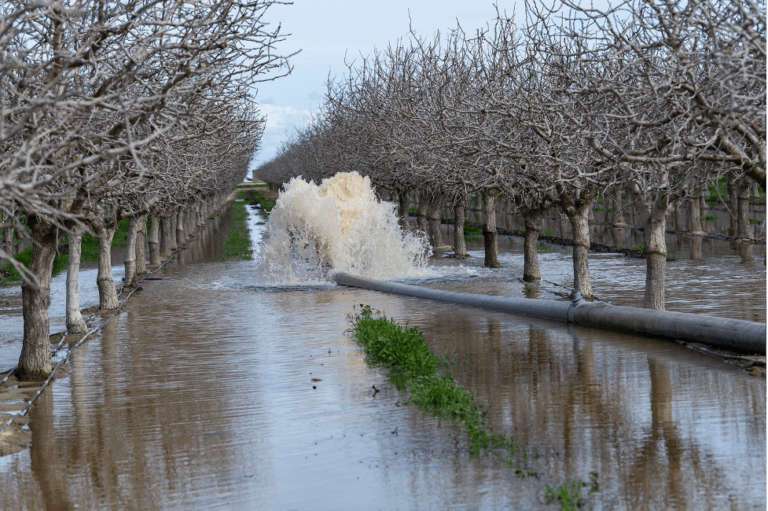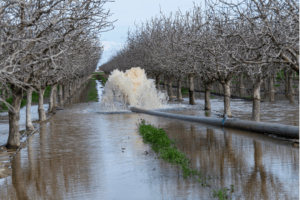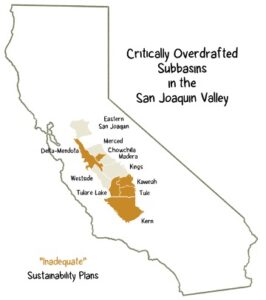Recharge is, for most, not an act of selfless generosity, but one of sheer self preservation. Local agencies hoping to comply with state laws that require they bring groundwater use to “sustainable” levels are counting on wet year recharge to make up some of the difference and lessen the impact to the state’s $49 billion agriculture industry. But creating the infrastructure necessary to actually capture that water is time-consuming and expensive. It requires particular soil conditions that don’t exist uniformly across the marbled ground of the valley floor – sandy dirt makes for quick recharge, while water sits on top of thick clay. Perhaps more importantly, it requires motivation and buy-in from individual landowners and small water agencies who have varying levels of motivation and interest.
Aaron Fukuda and the Tulare Irrigation District have been early recharge adopters. The district enjoys senior water rights to the Kaweah river, as well as contracts to federal project water, meaning that in all but the driest years, there are some supplies available for farmers to buy. But that water doesn’t add up to enough to keep the agency’s 201 growers in business. They make up the difference by pumping from underground. In 2022, deep in drought, Fukuda made the difficult decision to impose cut back allocations to growers, limiting their pumping for the first time. “Nobody was really happy with it, but I think they were willing to work with it, and see how it goes,” says Fukuda.” Then nine atmospheric rivers show up in December and January. And we flip the switch from, you have to live within this budget, to here’s your opportunity to put some savings in the ground and get credits. That decision last year paid dividends this year.”
The area’s growers are split roughly equally between dairies growing feed crops such as alfalfa and sorghum, and those with nut orchards that require irrigation year-round. They purchased water for a tiny fraction of what they might pay for it in drought times, and used it to overwater their crops and keep their canals and furrows full in the winter off-season. “Pre [groundwater regulations] there was one recharge agent in the district. We did all the recharge in our basins, in our canals,” says Fukuda. “Now we have 201 recharge agents, because our growers are doing it on their own.”
Extreme flooding events create an abundance of potentially unclaimed water – a danger, if you’re a small community downstream, or a boon if you’re a water agency that pays high prices for the resource during drought times. But state water law doesn’t conceive of “flood” water. Capturing it and recharging an aquifer is not considered a “beneficial” use. While Fukuda’s farmers have been able to sip and recharge without issue, because of the district’s antique water licenses, other valley farmers have been caught in a web of red tape.
Thousands of pistachio trees planted in neat rows across the San Joaquin Valley have leafed out for spring, lush and green, a testament to the state’s extensive financial and social investment in irrigated agriculture engineering. But the low spot in Terranova Ranch’s young orchard is noticeably bare and twiggy. This is where ranch manager Don Cameron got a little carried away.
“We finally found our limit here,” says Cameron, one of a few valley growers foolhardy enough to experiment on his own crop. This field was aggressively flooded for weeks on end in an attempt to maximize the ranch’s recharge capacity.
Considered by some at the Department of Water Resources to be “the godfather” of on-farm groundwater recharge, Cameron has been flooding both fallow and planted fields at Terranova for over a decade, turning his nut orchards and grape vineyards into small ponds whenever he has the chance. This was his first mishap, he says. “And we’ll learn from it.”
Elsewhere on the ranch, vegetable fields are converted into temporary recharge basins in flood times, where water percolates into the ground a few inches each day and is constantly topped up through a temporary hose. Other crops on the ranch are irrigated with flood water through what’s considered “in lieu” recharge, or foregone pumping. While the Kings River flows right along the ranch, Terranova does not have access to its water in most years, and instead relies on groundwater pumped from the underground aquifer. “My hope is we won’t have to turn on those pumps at all this year,” says Cameron, who aims for 25,000 acre feet recharged this year.
In other circumstances, what Terranova and other recharge projects are doing might run afoul of state water board regulations. Water law makes it legal to divert water from a river during a local flood emergency, but it does not allow for that water to be stored or used without a codified right that primarily considers the interests of the other, older rights along the waterway. With the board approving a scant few permits for recharge even as more storms pummeled the state, the governor’s office circumvented the agency with an executive order that broadly expanded agency and grower ability to recharge as they were physically able. It was also what gave Sarah Woolf the ability to turn on the pumps to pull water out of a flood bypass one county north of Terranova, at Triangle T.
“We’re making it more complicated than it needs to be. I think the governor’s executive order kind of proves that there are places where it can be simple, and we can let it happen,” says Woolf. “It’s very frustrating, and rightly so, for the general public to see that we’re not doing what seems so obvious to be doing.”
With a 2040 goal of “sustainability” in state groundwater laws, many potential recharge projects still only exist as ideas in management plans. The total recharge-specific permits approved by the state water board hit a record high this year – at just ten. Project managers must apply for permits well before the rainy season begins to have hopes of approvals in time to actually capture runoff, which can be a costly gamble. The board’s cheaper recharge permit is a fraction of the cost of a true water right, which can run upwards of $600,000 in application fees alone and take years to reach approval, but the $10,000 or more can still be onerous for small operations. Recharge advocates say the process is not nimble enough to meet the demand of not just new projects, but of a new climate. The board counters that this “streamlined” approach is far faster and less costly than its usual route. The science hinges on a “90/20 rule” that determines water is available for recharge if flows on a river exceed the 90th percentile according to US Geological Survey readings, so further study isn’t necessary.
“The state water board is dedicated to looking at ways to enhance recharge, and to help the process go as smoothly as possible for parties who are interested in it. We have multiple tools, different types of permits, and we stand ready to discuss projects and to assist parties with understanding our process,” says Amanda Montgomery with the water rights division at the State Water Control Board. But, she says, “we can only work with who comes to us.”
But for all the planning, engineering and infrastructure necessary to make recharge work, water systems engineer Phil Bachand sees the water rights as the most persistent hurdle to capturing and storing more storm water in a hotter, dryer climate. “The challenges are just not really understood. It’s like, let’s just put the water on the field and you’re good to go,” he says. “I’m just trying to demonstrate some successes to get things rolling. My intent is to try to change the state water board’s approach with their water rights permits to something that would be suitable, and easy and realistic.”
Without a significant shift toward more management and investment support for recharge, the groundwater debt will continue to accrue by millions of acre feet each year.
Compared to the costly work of raising and building dams, recharge infrastructure is cheap and fast. But its disaggregated nature is also anathema to the centralized gray water projects California has relied on for generations, and the management system that has enforced the rights to the water that is stored in those projects. Recharge permits that replicate the existing water rights system will also inherently replicate the inequities of that antique hierarchy. Flood water may want to spread, but in California, water rights tend instead to concentrate.
Susie Cagle is examining the unintended consequences of California’s water policies during her APF fellowship year.





